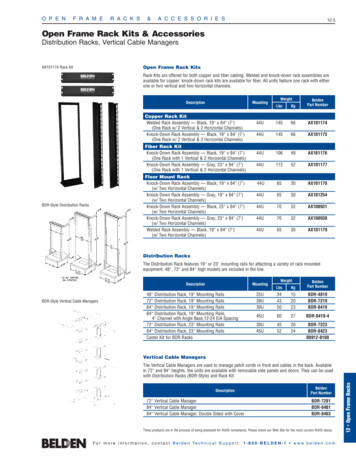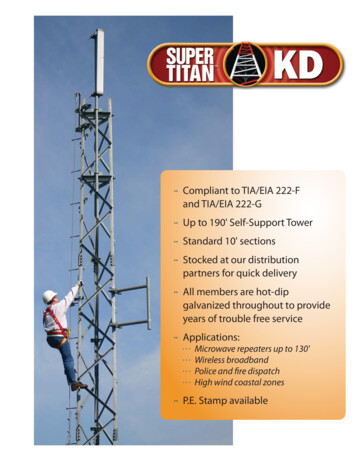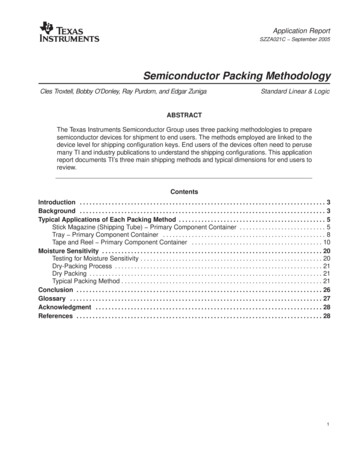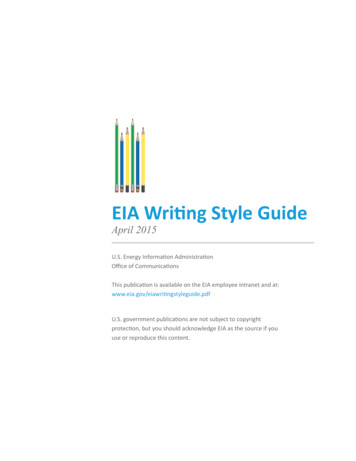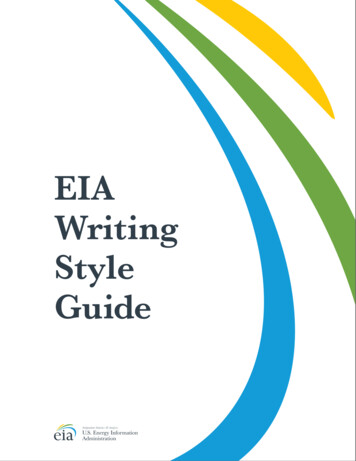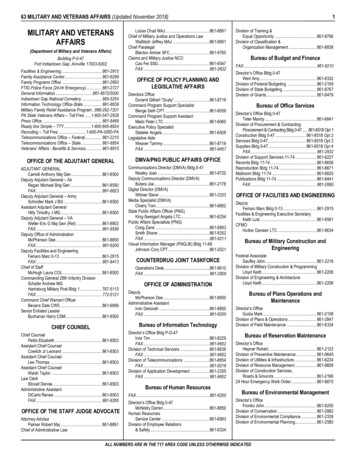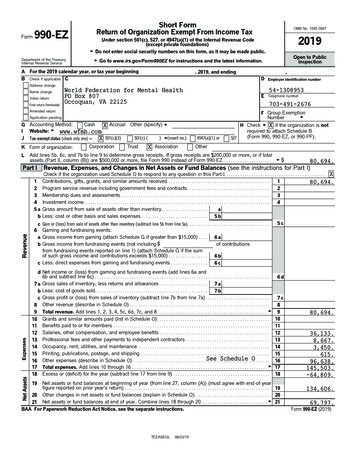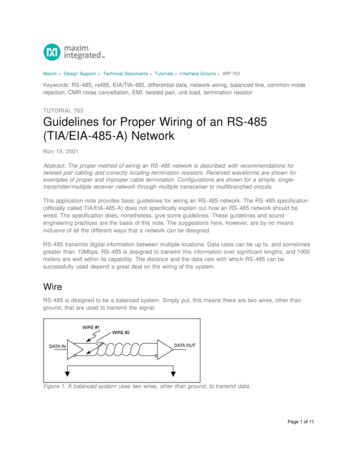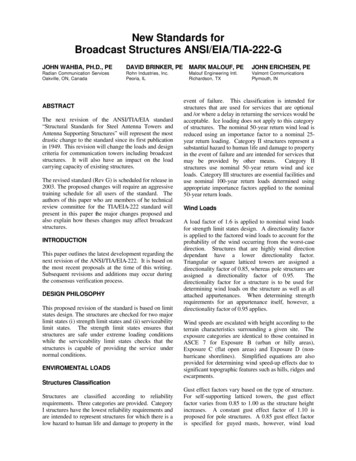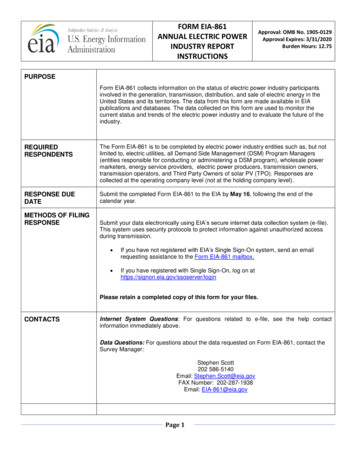
Transcription
FORM EIA-861ANNUAL ELECTRIC POWERINDUSTRY REPORTINSTRUCTIONSApproval: OMB No. 1905-0129Approval Expires: 3/31/2020Burden Hours: 12.75PURPOSEForm EIA-861 collects information on the status of electric power industry participantsinvolved in the generation, transmission, distribution, and sale of electric energy in theUnited States and its territories. The data from this form are made available in EIApublications and databases. The data collected on this form are used to monitor thecurrent status and trends of the electric power industry and to evaluate the future of theindustry.REQUIREDRESPONDENTSThe Form EIA-861 is to be completed by electric power industry entities such as, but notlimited to, electric utilities, all Demand Side Management (DSM) Program Managers(entities responsible for conducting or administering a DSM program), wholesale powermarketers, energy service providers, electric power producers, transmission owners,transmission operators, and Third Party Owners of solar PV (TPO). Responses arecollected at the operating company level (not at the holding company level).RESPONSE DUEDATESubmit the completed Form EIA-861 to the EIA by May 16, following the end of thecalendar year.METHODS OF FILINGRESPONSESubmit your data electronically using EIA’s secure internet data collection system (e-file).This system uses security protocols to protect information against unauthorized accessduring transmission. If you have not registered with EIA’s Single Sign-On system, send an emailrequesting assistance to the Form EIA-861 mailbox. If you have registered with Single Sign-On, log on athttps://signon.eia.gov/ssoserver/loginPlease retain a completed copy of this form for your files.CONTACTSInternet System Questions: For questions related to e-file, see the help contactinformation immediately above.Data Questions: For questions about the data requested on Form EIA-861, contact theSurvey Manager:Stephen Scott202 586-5140Email: Stephen.Scott@eia.govFAX Number: 202-287-1938Email: EIA-861@eia.govPage 1
FORM EIA-861ANNUAL ELECTRIC POWERINDUSTRY REPORTINSTRUCTIONSApproval: OMB No. 1905-0129Approval Expires: 3/31/2020Burden Hours: 12.75GENERAL INSTRUCTIONS1. Respondents, who also submit the Form EIA-861M (Formerly EIA-826), “Monthly Electric Power IndustryReport" should coordinate the information submitted on the Form EIA-861 and Form EIA-861M to ensureconsistency.2. For paper forms only, complete the information at the top portion of the form with the name, telephoneand FAX number, and email address of the current contact person and the contact person’s supervisor.3. Report peak demand in megawatts and energy values (e.g., generation and sales) in megawatthours,except where noted. One megawatthour equals 1,000 kilowatthours. To convert kilowatthours tomegawatthours, divide by 1,000 and round to the nearest whole number. For example, sales of5,245,790 kilowatthours should be reported as 5,246 megawatthours.4. Report in whole numbers (i.e., no decimal points), except where explicitly instructed to report otherwise.For example: revenue of 8,459,688.42 should be reported as 8,460 (thousand dollars). There is onedecimal place in the revenue on Schedules 2C and 4. Lines 2 and 4 on Schedule 6A and lines 3 and 4 onSchedule 6B also contain one decimal point.5. For the on-line form only, a State Code can only be removed by highlighting the state and clicking on the‘Remove record’ button. (Schedules 3A-C, 4A-D, 6A-D, 7A and 7B).6. For number of customers, enter the average of the 12 close-of-month customer accounts. All respondents having end-use customers, including retail power marketers selling power inderegulated, competitive state programs must use the average of the 12 close-of-month customercounts when reporting on Schedule 4, even if your company began business after the beginning ofthe reporting year, or ended business before the close of the year. Count each meter as a separate customer in cases where commercial franchises or residentialcustomer-buying groups have been aggregated under one buyer representative. The customercounts for public street and highway lighting should be one customer per community. Please do not count each pole as a separate customer even if billing is by a flat rate per pole permonth.7. Use a minus sign for reporting negative numbers. Line 9 on Schedule 2B must be a negative number.On Schedule 2B, line 1 and Schedule 2C, lines 4 and 6, the number may be either positive or negative.8. Where exact data are unavailable, report estimated data.9. See the Glossary for terms used in this survey. The financial and accounting terms are consistent asoutlined in the Uniform System of Accounts for Public Utilities and Licensees (U.S. of A.) (18 CFR Part101).Page 2
FORM EIA-861ANNUAL ELECTRIC POWERINDUSTRY REPORTINSTRUCTIONSApproval: OMB No. 1905-0129Approval Expires: 3/31/2020Burden Hours: 12.75Ownership CodesMunicipal Marketing Authority (A): Voted into existence by the residents of a municipality and givenauthority for creation by the state government. They are nonprofit organizations.Behind the Meter (B): Entities that install, own, and/or operate a system (usually photovoltaic), and sell,under a long term power purchase agreement (PPA) or lease, all the production from the system to thehomeowner or business with which there is a net metering agreement. Third Party Owners (TPOs) of PVsolar installations use this ownership code.Cooperative (C): Member-owned organizations.Nonutility DSM Administrator (D): Only involved with Demand-Side Management activities.Federal (F): Government agencies with the authority to deliver energy to end-use customers.Community Choice Aggregation (G): Public agency that aggregates end user’s electricity demand for aparticular area and manages supply for those users.Investor-Owned Utilities (I): Entities that are privately owned and provide a public service.Municipal (M): Entities that are organized under authority of state statute to provide a public service toresidents of that area.Political Subdivision (P) (also called "public utility district"): Independent of city or county government andvoted into existence by a majority of the residents of any given area for the specific purpose of providingutility service to the voters. State laws provide for the formation of such districts.Independent Power Producer or Qualifying Facility (Q): Entities that own power plants and sell theirpower into the wholesale market.Retail Power Marketer (R) or Energy Service Provider: Entities that market power to customers inrestructured markets.State (S): Entities that own or operate facilities or provide a public service.Transmission (T): Entities that operate or own high voltage transmission wires that provide bulk powerservices.Wholesale Power Marketer (W): Entities that buy and sell power in the wholesale market.SCHEDULE 1: IDENTIFICATION1. Survey Contact: Verify contact name, title, email address, telephone number, fax number.Page 3
FORM EIA-861ANNUAL ELECTRIC POWERINDUSTRY REPORTINSTRUCTIONSApproval: OMB No. 1905-0129Approval Expires: 3/31/2020Burden Hours: 12.752. Supervisor of Contact Person for Survey: Verify the contact’s supervisor’s name, title, address,telephone number, fax number and email address. Supervisor contact must be different than thesurvey contact.If any of the above information is incorrect or missing, please send revisions to EIA-861@eia.gov.Entity and Preparer Information3. Legal Name of Entity: Enter the legal name of the entity for which this form is being prepared.4. Current Address of Entity’s Principal Business Office: Enter the complete address, excluding thelegal name, of the entity’s principal business office (i.e., headquarters, main office, etc.).5. Preparer’s Legal Name: Enter the legal name of the company that prepares this form, if different fromthe Legal Name of Entity.6. Current Address of Preparer’s Office: Enter the address to which correspondence regarding this formshould be mailed, if different from the Current Address of Entity’s Principal Business Office. Includean attention line, room number, building designation, etc. to facilitate the future handling and processingof the Form EIA-861.SCHEDULE 2, PART A: GENERAL INFORMATION1. For line 1, please check all of the Regional Entities within the North American Electric ReliabilityCorporation (NERC), in which your organization conducts operations.The Regional Entities are: TRE (Texas Reliability Entity [ERCOT])FRCC (Florida Reliability Coordinating Council)MRO (Midwest Reliability Organization)NPCC (Northeast Power Coordinating Council)RFC (ReliabilityFirst Corporation)SERC (SERC Reliability Corporation)SPP (Southwest Power Pool, RE)WECC (Western Electricity Coordinating Council)2. For line 2, select the RTO or ISO from the list: California ISOElectric Reliability Council of TexasSouthwest Power PoolMidwest ISOPJM InterconnectionNew York ISOISO New EnglandNonePage 4
FORM EIA-861ANNUAL ELECTRIC POWERINDUSTRY REPORTINSTRUCTIONSApproval: OMB No. 1905-0129Approval Expires: 3/31/2020Burden Hours: 12.753. For line 4, Operate Generating Plant(s), check ‘Yes’ to indicate that your organization operated at leastone generating plant during the reporting period. Otherwise, check ‘No.’4. For line 5, Activities, check the appropriate activities the electric entity was engaged in during thereporting year. If your activity is not listed on line 5, include in Schedule 9. At least one activity must beprovided. Generation from company owned plant. Owned power generation. Transmission. Owned or leased transmission lines. Buying transmission services on other electrical systems. Types of services include borderlinecustomers, transmission line rental, transmission capacity, transmission wheeling, and systemoperational services. Distribution using owned/leased electrical wires. Power delivery to your own end-use customersover distribution facilities. Buying distribution on other electrical systems. Types of support include customer billing,distribution system support charges for energy delivered, line maintenance, and/or equipmentcharges. Wholesale power marketing. Wholesale transactions with other electric utilities, purchases frompower producers, and transactions to export and/or import electricity to or from Canada or Mexico.Also includes electrical sales and purchases among Federal Energy Regulatory Commission (FERC)registered power marketers and similar participation in transactions with electric utilities. Retail power marketing. Provision of electrical energy to end-use customers in areas where thecustomer has been given the legal right to select a power supplier other than the “traditional electricutility.” Combined services. Provision of electricity in combination with gas, water, cable, Internet, and/ortelephone for a single price.5. For line 6, Highest Hourly Electrical Peak System Demand (MW), electric utility companies shouldenter the maximum hourly summer load (for the months of June through September) based on net energyfor the system during the reporting year. Net energy for the system is the sum of energy an electric utilityneeds to satisfy their service area and includes full and partial wholesale requirements customers, andthe losses experienced in delivery. The maximum hourly load is determined by the interval in which the60-minute integrated demand is the greatest. If such data are unavailable, adjust available data toapproximate a 60-minute demand interval and explain the adjustment on Schedule 9 (Footnotes). Ifadjustments cannot be made, furnish data as available and explain on Schedule 9. For winter, enter themaximum hourly winter load (for months of January through March, and the previous December) basedon the net energy for the system during the reporting year. Please note: These data elements should beprovided in megawatts, to the nearest tenth.6. For line 7, Alternative-Fueled Vehicles, check ‘Yes’ to indicate that your company owns/operates, orplans to own and operate, alternative-fueled vehicles; otherwise check ‘No.’ If “Yes,” provide the name,title, FAX number, telephone number, and address of a contact person. Note: For the purpose of thisquestion, an “alternative-fueled vehicle” is either designed or manufactured by an original equipmentmanufacturer or is a converted vehicle designed to operate in either dual-fuel, flexible-fuel, or dedicatedmodes on fuels other than gasoline or diesel. This does not include a conventional vehicle that is limitedto operation on blended or reformulated gasoline fuels.Page 5
FORM EIA-861ANNUAL ELECTRIC POWERINDUSTRY REPORTINSTRUCTIONSApproval: OMB No. 1905-0129Approval Expires: 3/31/2020Burden Hours: 12.75SCHEDULE 2, PART B: ENERGY SOURCES AND DISPOSITION1. Enter the annual megawatthours (MWH) for all sources of electricity and disposition of electricity listed.2. For line 1, Net Generation, enter the net generation (gross generation minus station use) from allrespondent-owned plants. If a plant is jointly owned, enter only the reporting party’s share of generation.Include generation used to replace system losses arising from wheeling transactions. Include netgeneration supplied as part of a tolling arrangement.3. For line 2, Purchases from Electricity Suppliers, enter the total amount of energy purchased fromelectricity suppliers including: nonutility power producers and power marketers (reported separately inprevious years), municipal departments and power agencies, cooperatives, investor-owned utilities,political subdivisions, state agencies and power pools, and marketing agencies of the United StatesGovernment and Canada; these agencies include Bonneville Power Administration (BPA), SoutheasternPower Administration (SEPA), Southwestern Power Administration (SWPA), Western Area PowerAdministration (WAPA), Tennessee Valley Authority (TVA), United States Army Corps of Engineers, theUnited States Bureau of Reclamation, United States Bureau of Indian Affairs, International Boundary andWater Commission, Hydro-Quebec, etc. This entry includes requirements power, firm power, and allother non-firm service. Note: Please identify on Schedule 9, Footnotes, the portion of purchased powerobtained through tolling arrangements and international purchases.4. For line 3, Exchanges Received (In), enter the amount of exchange energy received. Do not includepower received through tolling arrangements.5. For line 4, Exchanges Delivered (Out), enter the amount of exchange energy delivered. Do not includepower delivered as part of a tolling arrangement.6. For line 5, Exchanges (Net), enter the net amount of energy exchanged. Net exchange is the differencebetween the amount of exchange received and the amount of exchange delivered (lines 3 and4). Thisentry should not include wholesale energy purchased from or sold to regulated companies or unregulatedcompanies for other systems.7. For line 6, Wheeled Received (In), enter the total amount of energy entering your system from othersystems for transmission through your system (wheeling) for delivery to other systems. Do not report asWheeled Received, energy purchased or exchanged for consumption within your system, which waswheeled to you by others.8. For line 7, Wheeled Delivered (Out), enter the total amount of energy leaving your system that wastransmitted through your system for delivery to other systems. If Wheeling Delivered is not preciselyknown, please estimate based on your system's known percentage of losses for wheeling transactions.9. For line 8, Wheeled (Net), enter the difference between the amount of energy entering your system fortransmission through your system and the amount of energy leaving your system (line 6 minus line 7).Wheeled net represents the energy losses on your system associated with the wheeling of energy forother systems.10. For line 9, Transmission by Others, Losses, enter the amount of energy losses associated with thewheeling of electricity provided to your system by other utilities. Transmission by Others, Losses shouldalways be expressed as a negative value.11. For line 11, Sales to Ultimate Customers, enter the amount of electricity sold to customers purchasingelectricity for their own use and not for resale. This entry should correspond to the revenue from sales toPage 6
FORM EIA-861ANNUAL ELECTRIC POWERINDUSTRY REPORTINSTRUCTIONSApproval: OMB No. 1905-0129Approval Expires: 3/31/2020Burden Hours: 12.75ultimate customers reported on Schedule 2 Part C, line 1, and should be equal to the totalmegawatthours reported on Schedule 4, Parts A, B and D, when summed for all reported states.12. For line 12, Sales for Resale, enter the amount of electricity sold for resale purposes. This entry shouldinclude sales for resale to power marketers (reported separately in previous years), full and partialrequirements customers, firm power customers, and non-firm customers. This entry should alsocorrespond to the revenue from sales for resale reported in Schedule 2 Part C, line 3. Note: Pleaseidentify on Schedule 9, the portion of sales for resale power sold through tolling arrangements and anyinternational sales.13. For line 13, Energy Furnished without Charge, enter the amount of electricity furnished by the electricutility without charge, such as to a municipality under a franchise agreement or for public street andhighway lighting. This entry does not include data entered in line 14.14. For line 14, Energy Consumed by Respondent without Charge, enter the amount of electricity usedby the electric utility in its electric and other departments without charge. This entry does not includedata entered in line 13.15. For line 15, Total Energy Losses, enter the total amount of electricity lost from transmission,distribution, and/or unaccounted for. This is the difference between line 10, "Total Sources," and thesum of lines 11, 12, 13, and 14. Total Energy Losses should always be expressed as a positive value.SCHEDULE 2, PART C: ELECTRIC OPERATING REVENUE1. All electric operating revenue data should be rounded to the nearest tenth and reported in thousanddollars; for example, revenue of 8,461,688.42 should be reported as 8,461.7 (thousand dollars).2. For line 1, Electric Operating Revenue from Sales to Ultimate Customers, enter the amount ofrevenue from sales of electricity to those customers purchasing electricity for their own use and not forresale. Revenue reported on Schedule 4C, for delivery service (and all other charges) should not bereported on Schedule 2C, line 1, but should be reported in Schedule 2C, line 2, Revenue fromUnbundled (Delivery) Customers. Revenue entered on line 1 is gross revenue and includes therevenue from state and local income taxes, energy or demand charges, customer service charges,environmental surcharges, franchise fees, fuel adjustments and other miscellaneous charges applied toend-use customers during normal billing operations. Revenue entered on line 1should not includedeferred charges, credits, or other adjustments, such as fuel or revenue from purchased power, fromprevious reporting periods which are included in Schedule 2C, line 4, Electric Credits/ OtherAdjustments. Revenue entered on line 1 should correspond to electricity sales reported in Schedule 2B,line 11. (Revenue entered on line 1 should also be the same total revenue reported on Schedule 4,column e (Total) for Parts A, B, and D, when summed for all reported states). Revenue entered on line 1should include all unbilled revenue resulting from power sold during the reporting period.3. For line 2, Revenue from Unbundled (Delivery) Customers, enter the amount of revenue fromunbundled customers who purchase their electricity from a supplier other than the electric utility thatdistributes power to their premises. This electric operating revenue does not include the charges forelectric energy but does include the revenue required to cover power delivery. Revenue entered on line 2should be the same total revenue reported on Schedule 4C, column e, when summed for all states.4. For line 3, Electric Operating Revenue from Sales for Resale, enter the amount of revenue from salesof electricity sold for resale purposes. This entry should include revenue from sales for resale towholesale or retail power marketers, full and partial requirements customers (firm), and to noPage 7
FORM EIA-861ANNUAL ELECTRIC POWERINDUSTRY REPORTINSTRUCTIONSApproval: OMB No. 1905-0129Approval Expires: 3/31/2020Burden Hours: 12.75requirements (non-firm) customers. This entry should also correspond to the sales for resale reported inSchedule 2B, line 12.5. For line 4, Electric Credits/Other Adjustments, enter the amount of deferred revenue, whichcorresponds to Account 449.1 of the Uniform System of Accounts including revenue not applied to enduse or resale customers during the normal billing cycle. Funds included in this entry consist of refunds tocustomers resulting from rate commission rulings delayed beyond the reporting year in which the fundswere originally collected. Also, include revenue distributions to customers from rate stabilization fundswhere the distribution occurred during the current reporting year but the funds were collected duringprevious reporting years.6. For line 5, Revenue from Transmission, enter the amount of revenue derived from the transmission ofelectricity for others (wheeling).7. For line 6, Other Electric Operating Revenue, enter the amount of revenue received from electricactivities other than selling electricity. This may include revenue from selling or servicing electricappliances, revenue from the sale of water and water power for irrigation, domestic, industrial orhydroelectric operations, revenue from electric plants leased to others, revenue from the sale of steam,but not including sales made by a steam heating department or transfers of steam under joint facilityoperations, revenue from interdepartmental rents or sale of electric property, revenue from late fees,penalties or reconnections, and revenue from interest.SCHEDULE 3, PART A: DISTRIBUTION SYSTEM INFORMATIONFor purposes of this schedule, a distribution circuit is any circuit with a voltage of 35kV or below that servesend use customers directly or through step-down transformers or substations. Circuits that are operated in aclosed-looped manner, i.e. not operated radially, are called ‘networked’. Networks serve key downtown ormetropolitan customers. Networks also provide sub-transmission supply to other distribution circuits throughstep-down transformers or substations. During outages to one or more network circuits, the customers areautomatically served by other network circuits with no interruption. For network primary systems, the circuitcount includes all circuits that supply the network. Where a circuit with a voltage of 35 kV or below is a sourcefor lower voltage circuits through step-down transformers or substations, the circuits at the higher voltage andthe lower voltage are included in the circuit count. Report this schedule if you own distribution lines.Volt/VAR Optimization (VVO) is a process used by electric distribution companies to actively manage voltagelevels and reactive power on distribution circuits in order to reduce energy losses and improve reliability andpower quality. VVO is typically achieved through the use of real-time information and controls that activatecapacitor banks, voltage regulators, and transformer load tap changers - and in some cases, distributedgeneration to adjust voltage and VAR levels on the primary and secondary distribution circuits.1. On line 1 enter the Total Number of Distribution Circuits.2. On line 2 enter the Total Number of Distribution Circuits that employ voltage/VAR optimization (VVO).Page 8
FORM EIA-861ANNUAL ELECTRIC POWERINDUSTRY REPORTINSTRUCTIONSApproval: OMB No. 1905-0129Approval Expires: 3/31/2020Burden Hours: 12.75SCHEDULE 3, PART B: DISTRIBUTION SYSTEM RELIABILITYINFORMATION - IEEEIf your entity calculates system average interruption duration index (SAIDI) and/or system average interruptionfrequency index (SAIFI) answer yes to question 1. If you determine Major Event Days in accordance with theIEEE standard, answer ‘yes’ to question 2 and complete Part B, otherwise answer ‘no’ to question 2 and completePart C. If your entity does not calculate SAIDI and SAIFI answer ‘no’ to question 1 and go to Schedule 4A.For lines 3 through 6 complete all that you calculate.Example 1, if you include all outage data in your SAIDI/SAIFI calculations, fill out the fields under the subtitle‘Including Major Events’.Example 2, if you do the calculations to find out which outages are major events or Major Event Days, excludemajor events or Major Event Days from the data and use the limited remaining data to calculate SAIDI and SAIFI,complete the area under the subtitle ‘Excluding Major Events’.1. The system average interruption frequency index, or SAIFI, indicates how often the average customerexperiences a sustained interruption (of over 5 minutes) over a predefined period of time. In this schedulereport annual SAIFI, or the SAIFI resulting from all interruptions in the reporting year. SAIFI is calculatedas the sum over the year of total number of customers that experienced an interruption of more than 5minutes, divided by the total number of customers.2. SAIFI [Sum of total number of customers interrupted over the year] / [Total number of customersserved]3. The system average interruption duration index, or SAIDI, indicates the total duration of interruptionfor the average customer over a predefined period of time. In this schedule report annual SAIDI, or theSAIDI resulting from all interruptions in the reporting year. SAIDI is calculated as the sum over the year ofall customers interrupted for more than 5 minutes times the number of minutes they experienced aninterruption, divided by total number of customers.4. SAIDI [Sum of customer minutes interrupted over the year] / [Total number of customers served]5. On lines 3 through 6 report the values that you calculate.a. Report the Annual Distribution SAIDI Including Major Event Days on line 3,b. Report the Annual Distribution SAIDI Excluding Major Event Days on line 3,c. Report both the Annual Distribution SAIDI Including Major Event Days excluding events where thereliability event was initiated from loss of supply (e.g. resulted from an event on the distributionsystem, not from the high-voltage system) the Annual Distribution SAIDI Excluding Major Event Daysexcluding events where the reliability event was initiated from loss of supply on line 4.d. Report the Annual Distribution SAIFI Including Major Event Days on line 5,e. Report the Annual Distribution SAIFI Excluding t Major Event Days on line 5,f. Report both the Annual Distribution SAIFI Including and Excluding Major Event Days excludingevents where the reliability event was initiated from loss of supply on line 6.Page 9
FORM EIA-861ANNUAL ELECTRIC POWERINDUSTRY REPORTINSTRUCTIONSApproval: OMB No. 1905-0129Approval Expires: 3/31/2020Burden Hours: 12.756. On line 7, enter the Total number of customers used to calculate SAIDI and SAIFI, as reported on thisschedule. A customer is defined as a metered electrical service point for which an active bill account isestablished at a specific location (e.g., premise). (IEEE 1366-2003 pg. 2)7. On line 8, indicate the voltage at which you distinguish the distribution system from the supplysystem.8. On line 9, indicate whether your company has an outage management system that detects loss of load orcustomer outages. Answer “yes”, even if you also receive outage information manually via other methods.SCHEDULE 3, PART C: DISTRIBUTION SYSTEM RELIABILITYINFORMATION – OTHERSAIDI and SAIFI calculations via other methods, calculated by state1. On lines 10 through 11 report the values that you calculate.a.b.c.d.Report the Annual Distribution SAIDI Including major events on line 10,Report the Annual Distribution SAIDI Excluding major events on line 10,Report the Annual Distribution SAIFI Including major events on line 11,Report the Annual Distribution SAIFI Excluding major events on line 11.2. On line 12, enter the total number of customers used to calculate SAIDI and SAIFI, as reported on thisschedule.3. On lines 13, indicate whether your utility includes inactive accounts in its definition of customers used todetermine SAIDI and SAIFI.4. On line 14, indicate how your utility defines momentary outages, i.e., less than how many minutes.Outages can be classified as either momentary or sustained. Momentary outages are not included indetermining SAIDI and SAIFI.5. On line 15, report the voltage that you use to distinguish the distribution system from the supply system.6. On line 16, indicate whether your company has an outage management system that detects loss of loador customer outages. Answer “yes”, even if you also receive outage information manually via othermethods.SCHEDULE 4, PART A: SALES TO ULTIMATE CUSTOMERS.FULL SERVICE – ENERGY AND DELIVERY SERVICE (BUNDLED)The table below should be used as a guide for the classification of your end-use customers; pay closeattention to how your consumers should be organized based on our four Sectors: Residential, Commercial,Industrial, and Transportation. Please note that data for the Transportation Sector (see definitions) hasreplaced the “Other” Sector on all parts of Schedule 4. Non-Transportation customers previously reportedunder “Other,” including street and highway lighting, should now be included in the Commercial Sector.Irrigation customers should be reported in the Industrial Sector.Enter the reporting year revenue (thousands of dollars, to the nearest tenth), megawatthours, and number ofcustomers for sales of electricity to ultimate customers by state, balancing authority, and customer classPage 10
FORM EIA-861ANNUAL ELECTRIC POWERINDUSTRY REPORTINSTRUCTIONSApproval: OMB No. 1905-012
Submit your data electronically using EIA's secure internet data collection system (e-file). This system uses security protocols to protect information against unauthorized access during transmission. If you have not registered with EIA's Single Sign-On system, send an email requesting assistance to the Form EIA-861 mailbox.
